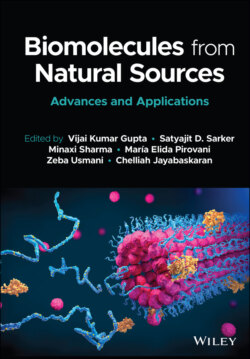Читать книгу Biomolecules from Natural Sources - Группа авторов - Страница 29
1.8 Surface-Active Properties
ОглавлениеBiosurfactants are surface-active compounds, capable of reducing surface and interfacial tension at the interfaces between liquids, solids and gases, allowing them to mix or disperse readily as emulsions in water or other liquids.
Surfactant-related parameters are surface tension, maximum surface excess value, minimum surface area occupied by the surfactant molecule at the air–water interface at saturated adsorption, the minimum concentration of the surfactant required to reduce surface tension and the Gibbs free energy of adsorption (Marqués et al. 2009). The interfacial tension, the emulsification index, and the hydrophilic lipophilic balance (HLB) are other important surface active parameters. The interfacial tension is usually measured by tensiometry. The emulsification index is the direct indication of the amount of surfactant. Afterwards the emulsification index can be monitored during the course of fermentation to evaluate the production of trehalose lipids, by mixing an equal volume of cell free broth and liquid paraffin (Cooper and Goldenberg 1987).
Moreover, surface tension has a tendency to decrease with the increase of glycolipid concentration. The structural diversity of glycolipids structures originate different surfactant properties. Generally they are able to reduce the surface tension of water to 43–24.1 mN m-1 and present CMC values of 0.7–37 mg L-1 (Marqués et al. 2009; Tuleva et al. 2009; Yakimov et al. 1999).
The trehalose lipids are able to reduce the surface tension of the water, for instance from 72 to 34 mN m-1 (Janek et al. 2018). This is in agreement with most trehalose lipids produced from Rhodococcus, with strong surface activity by lowering water surface below 30 mN m-1, lowering the interfacial tension against hexadecane up to 1 mN m-1. An example, is a purified trehalose lipid, produced by a novel marine bacterium Rhodococcus sp. PML026 using sunflower oil as a hydrophobic substrate, being able to reduce the surface tension of water to 29 mN m-1 with a CMC value of 250 mg L-1 (White et al. 2013).
Marqués et al. (2009) analyzed the chemical and physical properties of a glycolipid synthesized by Rhodococcus sp. 51T7. They demonstrated that this biosurfactant was a trehalose tetraester (THL) consisting of six components: one major and five minor. The hydrophobic moieties ranged in size from 9 to 11 carbons. The critical micelle concentration (CMC) was 37 mg L-1 and the interfacial tension against hexadecane was 5 mN m-1. At pH 7.4 the trehalose lipid CMC/critical aggregation concentration (CAC) was 50 mg L-1 and at pH 4 it was 34 mg L-1 (Marqués et al. 2009). A break at around 40 mg L-1 was consistent with the CMC/CAC obtained from surface tension measurements. An increase in pH (4–7.4), CAC values increased as the more negatively charged carboxylate group of trehalose lipid tends to complicate aggregation. When NaCl was added at pH 7 trehalose lipid behaved in a non-ionic way and the CAC was unaffected. A phase diagram showed effective emulsification with water and paraffin or isopropyl myristate. A composition of 11.3–7.5–81.8% (isopropyl myristate–trehalose lipid–water) was stable for at least three months. The HLB was 11 and the phase behaviour of the glycolipid revealed the formation of lamellar and hexagonal liquid-crystalline textures (Marqués et al. 2009).
Depending on the Rhodococcus sp. the different trehalose lipids produced changes in interfacial tensions, critical micelle concentrations and emulsifier index and biologic activity.
